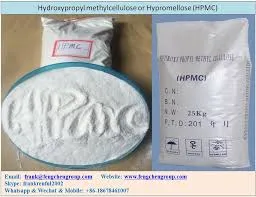
ئۆكتەبىر . 30, 2024 15:47 Back to list
hydroxypropyl methyl cellulose manufacturer
Hydroxypropyl Methyl Cellulose A Versatile Additive in Various Industries
Hydroxypropyl Methyl Cellulose (HPMC) is a versatile, non-ionic cellulose ether derived from natural cellulose. It has gained significant popularity across various industries due to its exceptional properties and functional benefits. Manufacturers of HPMC cater to a wide range of applications, including construction, pharmaceuticals, food, and personal care products.
Properties and Characteristics
HPMC is known for its water solubility and ability to form gels, making it an ideal thickening agent, emulsifier, and stabilizer. Its chemical structure allows for a broad range of viscosity levels and gel strengths, which can be tailored to meet specific industry needs. Additionally, HPMC is characterized by its excellent film-forming properties, making it suitable for coatings and binders in various formulations.
One of the key advantages of HPMC is its thermal stability and resistance to heat, which enables it to maintain performance under extreme conditions. Moreover, as a cellulose derivative, HPMC is biodegradable and environmentally friendly, appealing to manufacturers striving to reduce their ecological footprint.
Applications
hydroxypropyl methyl cellulose manufacturer

In the construction industry, HPMC plays a vital role as a water-retaining agent in cementitious materials. It improves workability, enhances adhesion, and increases the open time of mortars, making it indispensable in tile adhesives, spray plasters, and grout formulations. Manufacturers in this sector emphasize HPMC’s ability to create a homogenous mix, ensuring superior performance and durability in building materials.
In the pharmaceutical field, HPMC serves multiple functions, including acting as a binder in tablet formulations and a matrix-forming agent in sustained-release products. Its non-toxic nature and compatibility with many active pharmaceutical ingredients make it a preferred choice for formulators. Furthermore, HPMC is frequently used in ophthalmic products for its lubricating properties, providing relief for dry eyes.
The food industry also benefits from HPMC, where it is utilized as a thickener, stabilizer, and emulsifier in various food products. It helps improve texture, retain moisture, and ensure homogeneity, which is essential for processed food items. Manufacturers focus on HPMC’s capability to enhance food quality while meeting food safety regulations.
Personal care manufacturers utilize HPMC in a variety of applications, including skincare and hair care products. As a thickening agent, it helps achieve the desired viscosity while providing a smooth, pleasant texture. HPMC is often found in lotions, creams, shampoos, and gels, contributing to the overall aesthetic appeal of these products.
Conclusion
Hydroxypropyl Methyl Cellulose has established itself as an essential additive across multiple industries due to its unique properties and versatility. As manufacturers continue to innovate and develop new applications, HPMC's role will likely expand, further enhancing product performance and promoting environmentally sustainable practices. The growing demand for HPMC underscores its significance in modern formulations, highlighting its importance to manufacturers and consumers alike. As industries evolve, HPMC stands poised to meet the challenges of tomorrow with efficacy and adaptability.
-
Versatile Hpmc Uses in Different Industries
NewsJun.19,2025
-
Redispersible Powder's Role in Enhancing Durability of Construction Products
NewsJun.19,2025
-
Hydroxyethyl Cellulose Applications Driving Green Industrial Processes
NewsJun.19,2025
-
Exploring Different Redispersible Polymer Powder
NewsJun.19,2025
-
Choosing the Right Mortar Bonding Agent
NewsJun.19,2025
-
Applications and Significance of China Hpmc in Modern Industries
NewsJun.19,2025







